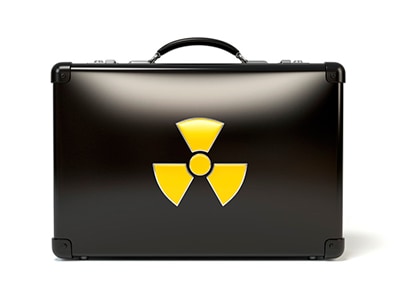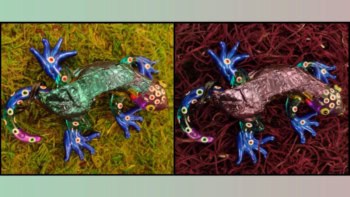
A new technique that uses laser pulses to detect concealed radioactive materials has been proposed by physicists at the University of Maryland in the US. It works by spotting ionized oxygen molecules created by gamma radiation and uses relatively cheap lasers. The technique is being field-tested and could be used for the remote detection of materials used to create “dirty bombs”, which combine conventional explosives with radioactive materials.
Despite being strictly controlled, radioactive materials are used routinely in hospitals and also for industrial-imaging applications such as testing welded seams. Terrorists could therefore, in principle, get their hands on the ingredients for making a dirty bomb. While the conventional blast from such a bomb is likely to be more deadly than the resulting radioactive contamination, dirty bombs could contaminate large areas, and lead to public panic and costly clean-up operations.
Security services are therefore keen to develop ways of detecting contraband radioactive material without have to get so close to a suspect object as to pose a health risk to personnel. One way of detecting nuclear contraband is to directly measure the radiation it emits using a Geiger counter or other radiation detector. This is often not practical, however, because it requires getting relatively close to a suspect object.
Environmental effect
Another approach is to measure the effect of emitted radiation on the surrounding environment, ideally from several hundred metres away. In the case of gamma-ray emitters, such as cobalt-60 and isotopes of polonium, emitted radiation collides with air molecules creating a cascade of lots of low-energy electrons. Some of these electrons will then attach themselves to oxygen molecules in the air, creating negative ions.
Now, Phillip Sprangle and colleagues in Maryland have worked out a way to detect the presence of these ions using two lasers. Their technique involves firing a low-intensity laser beam at the air surrounding a radioactive source, which increases the number of negative ions created by the gamma rays. A high-intensity laser pulse is then fired at the same region to create an avalanche electrical breakdown – essentially a spark that forms in the air. Once the spark has fully formed, the air acts like a mirror, reflecting the laser pulse back to a detector.
Knowing when the pulse is fired and when it is reflected back gives the time required for the spark to form. This time can then be related to the number of oxygen molecules ionized by the radioactive source – and the strength of the source itself. So by comparing the spark formation times in two different regions, the technique can determine if there is more radioactive material in one region than another.
Small quantities
The team has calculated that its technique could be used to detect 10 mg of cobalt-60 from a distance of several hundred metres. This could be done by shining the lasers at a region about 0.5 m away from the radioactive material. Sprangle points out that 10 mg is a much smaller amount of material than would be used in an effective dirty bomb.
Although other techniques have been proposed for measuring electrical breakdown near radioactive sources, they have their challenges. One uses terahertz radiation, which is difficult to create and detect, while another involves a high-powered infrared laser that has to be fired through the region of interest and then on to a detector behind the target. “We believe that our concept is more immediately practical, as it relies on well-developed technology, and also doesn’t require the detector to be located opposite the target from the laser source,” Sprangle told physicsworld.com.
He points out, however, that the technique is not appropriate for detecting all types of radioactive material. “Our technique would have difficulty detecting charged-particle emitters, as the emitted particles typically have very short ranges compared to gamma emitters such as cobalt-60, so they only cause elevated ion levels very close to the radioactive source.”
The technique is currently being tested at the University of Maryland and is described in Physics of Plasmas.



